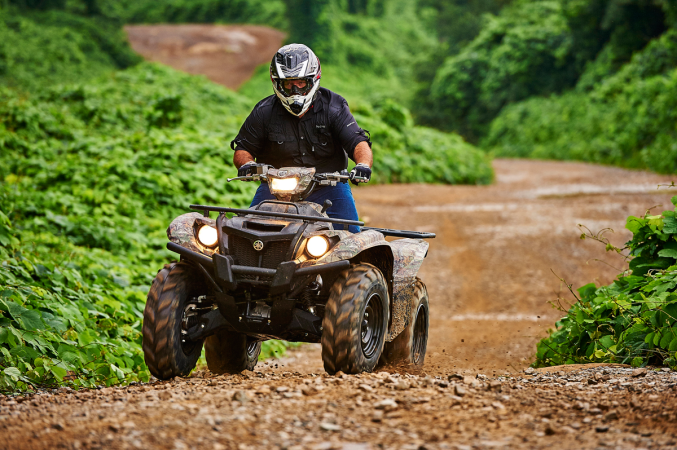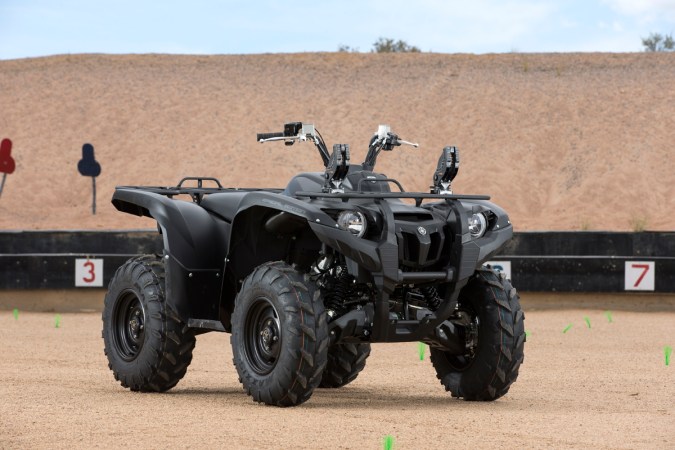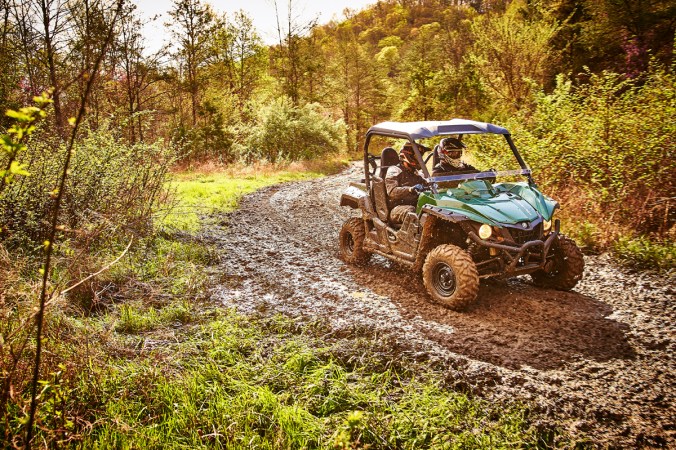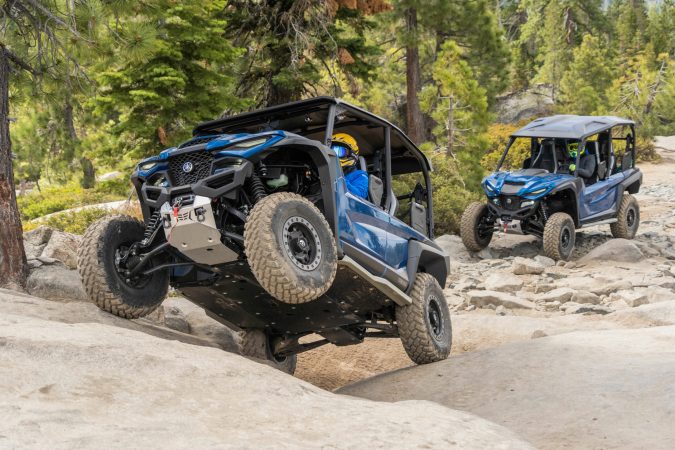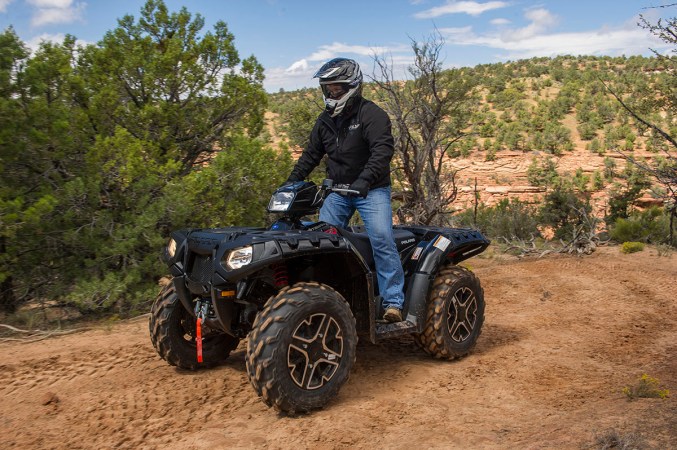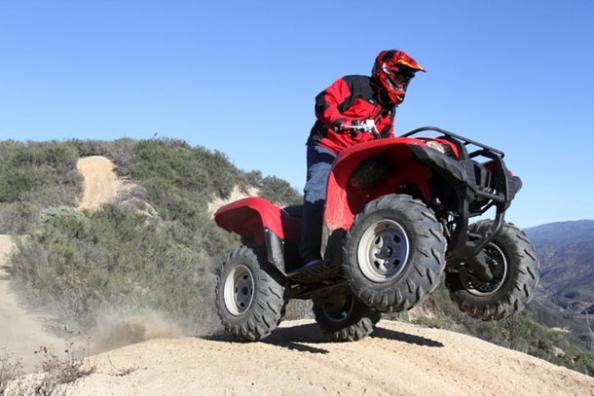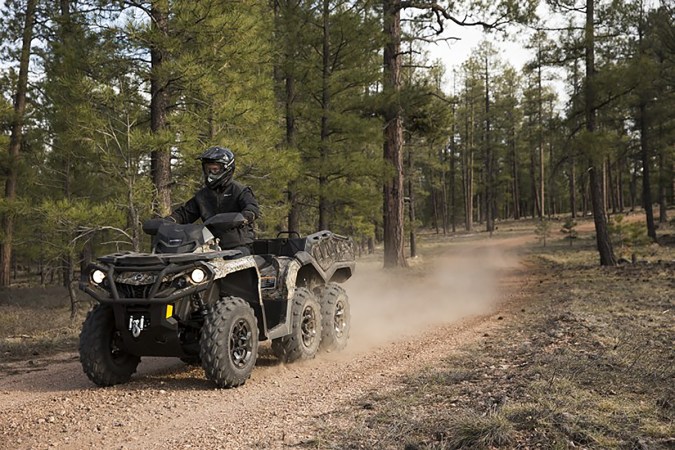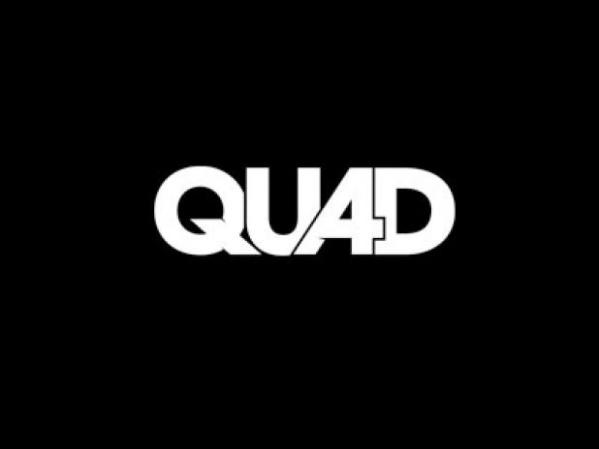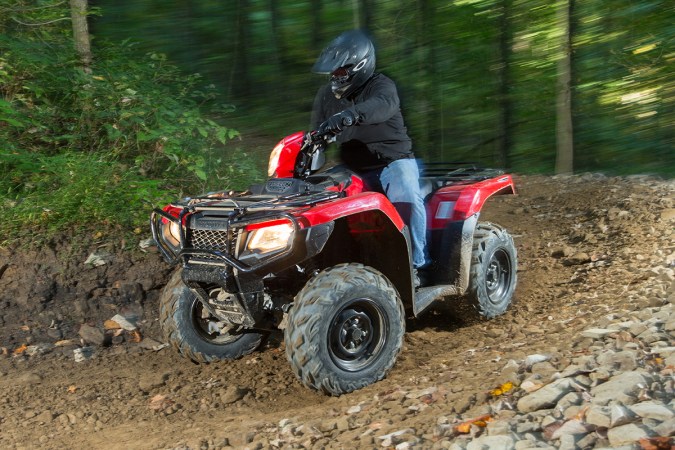We may earn revenue from the products available on this page and participate in affiliate programs. Learn More ›
2012 Yamaha Rhino 700 FI Auto
MSRP: $11,499 – Hunter Green, Steel Blue; $12,049 – Real Tree AP Camo
Yamaha entered the Side-By-Side (SxS) market with the venerable Rhino 660 in 2004, and introduced the world to the first sport-utility machine equally capable of both hard work and hard play. The Rhino 660 helped spawn the SxS racing craze and jump-started a host of new aftermarket companies that blew custom Rhino parts out the door as fast as they could produce them. In 2007, the Rhino 700 FI Auto took the platform to a new level with the enhanced fuel-injected 700-class engine. Since then the Rhino 700 FI Auto has remained virtually unchanged, and is still one of the toughest and most reliable machines on the planet.
Additionally, one of the coolest things about the Rhino and numerous other Yamaha ATV’s is the fact that they’re all built in Newnan, Ga., using parts sourced from vendors all over the country.
Engine/Transmission/Drivetrain
Performance:
The Rhino has respectable power and torque, which is transferred to the ground through Yamaha’s excellent Ultramatic CVT transmission. I used the Rhino to do plenty of work around my property, including pulling a Bosski ATV Wagon filled with shale. It had plenty of power to do all of these tasks, and was fun to drive. It is small compared to competitors like the Can-Am Commander and Kawasaki Teryx, which gives the Rhino the ability to squeeze through obstacles that would rip body parts off the bigger machines.
The large fuel-injected 700cc single cylinder engine produced noticeable vibration at idle, but smoothed out nicely as engine RPM increased. Top speed is limited to around 40 mph, but I never felt like the need to go any faster for the terrain I used the Rhino in. Cold weather starting was effortless and the fuel injection did a nice job of compensating for atmospheric conditions and altitude changes.
The transmission incorporates an effective and natural feeling engine brake that utilizes the engine’s natural compression to help slow down the machine. Yamaha’s unique 4×4 selector makes it easy to switch between 2WD, 4WD, and 4WD with differential lock.
Hits
– Powerful engine has legendary reliability.
– Ultramatic Transmission is smooth and operates quietly.
– Uniquely designed four-wheel drive and differential lock switch.
Misses
– Due to a gigantic 700cc single cylinder, the Rhino has a noticeable amount of vibration at idle.
Chassis/Suspension
Performance:
The four-wheel independent suspension provided a smooth comfortable ride over the countless miles of rough terrain the Rhino and I negotiated together. The 12.1 inches of ground clearance allows the Rhino to be driven over obstacles, rather than into them. The handling is precise with no observable pushing, even with the bed loaded to capacity or with a trailer in tow. The Rhino lacks Electric Power Steering (EPS). Although there is no doubt it would benefit from such a great addition, the steering effort is incredibly light and remains unaffected by rough terrain.
The four-wheel disc brakes are strong and resist fading, even when the Rhino is pushed to capacity. The chassis is strong and doesn’t creak, groan, or flex like some of the other competitors in this category.
Hits
– Incredibly strong chassis.
– Smooth riding four-wheel independent suspension.
Misses
– No EPS option available.
– No tilt steering.
Ergonomics
Performance:
With a hood and bed that both tilt up, and seats and a center console that are easily removed, the Rhino 700 is one of the easiest SxSs on the market to pressure wash and do maintenance on. The stamped steel dump bed is tough—I never worry about the bed not being able to handle the giant logs or loads of gravel or mulch I put on it. The dual latching tailgate keeps bouncing debris from inadvertently popping the gate open.
The molded half-doors work well for keeping mud, flying debris, and branches out of the cabin. They also do a nice job of keeping the occupants’ legs safely within the confines of the cab. I would love to see a door that’s another 12 inches higher on future models, though, which would afford the Rhino even more protection.
Hits
– Accessing the engine is simple and effortless, the way it should be on all SxSs.
– A flip up hood and bed make pressure washing the Rhino simple.
Misses
– The molded doors are an asset, but higher doors would be even more advantageous.
Fit/Finish
Performance:
Many ATV and SxS owners are also do-it-yourselfers who like to perform their own maintenance service to help prolong the life of their machine while also saving a few bucks. The battery, airbox, and electronics are easily accessible under the flip-up hood—you can get to them without tools—so servicing the Rhino 700 is a breeze.
The Rhino has excellent fuel efficiency. And the high capacity, 7.9-gallon fuel tank provides an extended range for long-distance adventures.
The new Maxxis tires are lightweight, durable, and provide impressive traction. The area where I test is chock full of very sharp blast-rock, which is notorious for shredding weak stock tires. They withstood a beating without suffering a flat.
Hits
– Ease of access make servicing more doable for the Average Joe.
– Maxxis tires are lightweight, durable, and provide impressive traction.
– High capacity fuel tank means long distance adventures.
Misses
– Interior and amenities look and feel dated.
Final Thoughts:
The Rhino 700 may not be the fastest SxS or have the longest suspension travel or the highest load capacity. And it certainly doesn’t have the passenger capacity to taxi an entire basketball team. However, it places in the hearts of the outdoor crowd because it does everything well and in a refined manner, which is Yamaha’s style. If you are in the market for a SxS that can get you to your favorite hunting spot, do work around the house or farm, and is sporty enough to hit the trails or the dunes, consider the Yamaha Rhino 700 FI Auto.
SPECIFICATIONS:
Engine
Type – 686cc liquid-cooled w/fan, 4-stroke; SOHC, 4 valves
Bore x Stroke – 102.0 x 84.0mm
Compression Ratio – 9.2:1
Fuel Delivery – Yamaha Fuel Injection (YFI) , 41mm
Ignition – 32 Bit ECU
Starting System – Electric
Transmission – Yamaha Ultramatic® V-belt with all-wheel engine braking/H, L, N, R
Drive Train – Yamaha On-Command® push-button;3-way locking differential; 2WD,4WD, locked 4WD; shaft drive
Chassis
Suspension / Front – Independent double wishbone; 5-way preload adjustment, 7.3-in travel
Suspension / Rear – Independent double wishbone; 5-way preload adjustment, 7.3-in travel
Brakes / Front – Dual hydraulic disc, twin piston
Brakes / Rear – Dual hydraulic disc
Tires / Front – AT25x8-12 NHS
Tires / Rear – AT25x10-12 NHS
Dimensions
L x W x H – 113.6 x 56.6 x 73 in
Wheelbase – 75.2 in
Turning Radius – 153.5 in
Ground Clearance – 12.1 in
Fuel Capacity – 7.9 gal
Wet Weight – 1199 lb
Bed Capacity – 400 lb
Towing Capacity – 1212 lb
Other
Instrumentation – Digital LCD Multifunction display; speedo, odo, dual trip, hour, clock, fuel, and gear position
Lighting – Dual 30W Krypton multi-reflector headlights & dual 21/5W brakelight
Warranty – 6 Month (Limited Factory Warranty)


